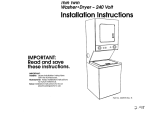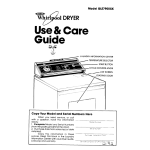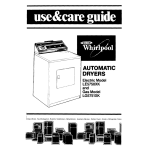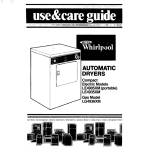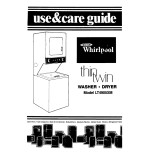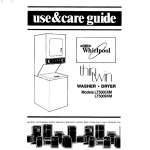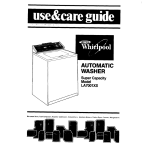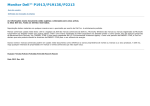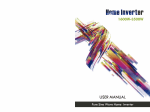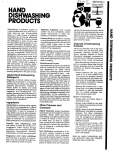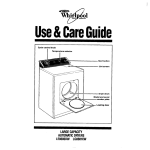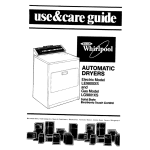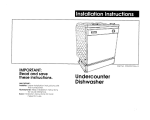Download Whirlpool LT4900XS User's Manual
Transcript
. thin Wir . WASHER l DRYER Model LT49OOXS Ishers, Clolhes Dryers, Freezen, RelriSeralor-FreeleT, Ice Makers. Dishwashers BullI-In Ovens and Sudace Unils. Ranaes. Microwave Ovens. Trash Compac Parts and features LINT SCREEN DRYER DRUM WASHER CONTROLS SELECTOR SWITCH DRYER CONTROLS WASHER LID LATCH OPTIONAL EXHAUST OUTLET LINT FILTER (Not Shown) BASKET / AGITATOR / / TUB Remove the Consumer Buy Guide label. It will be easier to remove before the washer l dryer is used. You should wipe out the washer basket and dryer drum with a damp cloth before using to remove dust from storing or shipping. Copy your Model and Serial When you need service or call with a question, have this information ready 1. Complete Model and Serial Numbers (from the plate located as shown). 2. Purchase date from sales slip. Copy this information in these spaces. Keep this book, your warranty and sales slip together in a handy place. Please complete this product. 2 and mail the Owner Numbers here Complete Model Complete Serial Number Number Purchose Dole Serwce Company Telephone Registration and Number Card furnished with Contents Page PARTS AND FEATURES BEFORE USING YOUR WASHER*DRYER IMPORTANT SAFETY INSTRUCTIONS WASHER OPERATING INSTRUCTIONS Starting Your Washer What Happens in Each Cycle . OTHER OPERATING INSTRUCTtONS For a Rinse and Spin For a Drain and Spin . For Q Soak or Pre-Wash Cleaning the Lint Filter DRYER OPERATING INSTRUCTIONS 2 3 4 6 6 8 12 12 12 12 13 Starting Your Dryer Selecting a Cycle DRYING TIPS Drying Times Mixed Loads LINT SCREEN LINT REMOVAL CARING FOR YOUR WASHER-DRYER Cleaning Dryer Interior Vocation Core Voltage Requirements Winterizing IF YOU NEED SERVICE OR ASSISTANCE “THIN TWIN” WARRANTY Page 13 14 16 16 16 17 17 18 18 19 19 19 20 24 13 01987 Whirlpool Corporation . Before using your THIN TWIN” washeredryer For best washing and drying results, you must take some very important steps before, during and after each load: 1. Prepare and sort each load for washing, (see your”Laundry Guide”]. 2. Measure and add detergent or soap to washer, (see your “Laundry Guide”). 3. Load the washer properly, (see your “Laundry Guide”). 4. Select the water temperature, load size and cycle recommended for the fabrics before staiting the washer, (see pages 6 and 7 of this book). 5. Add other laundry aids to the washer according to instructions, (see your “Laundry Guide”). 6. Properly sort the load for drying, (see your “Laundry Guide”). 7. Select the right drying cycle and time for the fabrics, (see pages 14-16of this book). 8. Remove and hang or fold items lmmedlately after drying. Important Safety Instructions and Your Responsibilities ALWAYS unplug the power supply cord before attempting to service the washer/dryer. DO NOT machine wash glass fiber materials Small particles can stick to fabrics washed in following loads and cause skin irritation. HAZARDOUS FUMES can be formed if chlorine bleach is used in the same wash as ammonia or acids such as vinegar or rust remover. ALWAYS store detergent, laundry aids and other materials in a cool, dry place where children can’t reach them - in a locked cabinet if possible. ALWAYS read and follow instructions on packages of detergent and laundry aids - especially warnings and precausions. NEVER operate the washer/dryer if... l it is not working right. l it is damaged. l parts are missing. l all panels are not in place. You are personally responsible for making sure that your washer/dryer: l is properly maintained. l is properly installed and leveled in a well ventilated room on a floor that can support the weight: l is located in an area where the temperature is above 45°F (7.2”C) because... -the dryer will not operate properly at cold temperatures. - freezing temperatures can damage the washer. l is connected to the proper electrical supply, outlet, water supply, plumbing fixtures, drain, and other dryer exhausting system? l is not installed against drapes or curtains.* l is used only for jobs normally expected of home automatic washer/ dryers. *Refer to the “Installation Instructions” for complete information. Washer operating instructions Starting Your Washer Be sure to measure and add detergent, then place a sorted load in the washer before starting it. 1. l Position SELECTOR SWITCH Move Selector Switch to WASHER position. Washer will not operate when switch is in DRYER position. 3. Select WATER TEMPERATURES 2. SELECT A LOAD SIZE Turn the knob to point at a setting that describes the size of load You want to wash l The water level can be set for EX SMALL, MEDIUM or LARGE loads. Select the water level that matches the load size. See your “Laundry Guide” for details on load sizes. l LOAD SIZES AND WATER LEVELS For best cleaning results, the load must be able to move freely in the water. Too big a load or too little water can tear items. Match the wash water temperature to the type of fabrics and soils being washed. Recommended wash temperatures can be.found in your “Laundry Guide: 6 l LARGE 11.3gal. (42.7 L) MEDIUM ’ 8.5 gal. (32.1 L) EX SMALL 5.6 gal. (21.2 L) 4/z!F!3 *Approxlmole 1111wth load 4. Select CYCLE and WASH TIME; Start the Washer A. Push in the Control Knob and turn it to the right. It must be pushed in and turned only clockwise. B. C. Start the washer by pulling out the Control Knob. The washer will fill to the level you set with wash water of the selected temperature. After filling, the washer will agitate for the selected number of minutes. D. Stop on a number ln the cycle you want. The numbers are minutes of wash time. The drawing shows 12 minutes of agitation in the REGULAR/ HEAVY Cycle. To stop the washer at any time, push in the Control Knob. To restart the washer, pull out the Control Knob. To set the controls for a rinse and spin, a drain and spin, or a soak or prewash, see page 12. 7 What Happens in Each Cycle* Each cycle has diflerent agitation and spin speeds designed for different kinds of fabrics. Numbers on the dial in each cycle are the minutes of WASH agitation time. When the Cycle Control Knob is set to a number and pulled out,the washer fills before agitation and timing starts. After agitation starts, the knob turns REGULAR HEAVY Cycle WASH 10 Minutes Low Speed 4 cycle for sturdily constructed fabrics that are heavily soiled. REGULAR NORMAL Cycle A cycle for sturdily constructed fabrics that are moderately soiled. PERMANENT PRESS NORMAL A special cycle wi;h the necessary cool-down rinse which helps keep wrinkles from setting into Permanent Press and some synthetic fabrics. Cycle DRAiN No Agitation clockwise until it points to OFF and the cycle ends. NOTE:You may hear the sound of water spraying some cycles. In some cycles, cold water is sprayed help with the rinsing. Gentle during the spin parts of on the spinning load to Wash System For better fabric care in the REGULAR and PERMANENT PRESScycles, agitation speed is reduced during the last few minutes of wash time. Ii WASH Low Speed I I NOTE: Always use cold rinse water permanent press fabrics for the KNITS/GENTLE Cycle A cycle that gently washes and spins delicate items and washable knits. Wash nylon hose in a net laundry bag. SOAK and PRE-WASH Cycles Periods of agitation and soaking time help remove heavy soils and certain stains that need extra pretreatment. Use recommended amount of detergent. The SOAK Cycle should always be followed by a Wash Cycle. SUPER WASH Cycle Use for washing heavily soiled loads that require maximum soil removal. Double the amount of detergent recommended when using the SUPER WASH Cycle. 10 A Indicates the machine is pauslng for a brief soak period. DRAiN No Agitation p!i#yiq~~ I Pre-wash setting (see page 12). begins here, Special care is needed when soaking or pre-washing See your “Laundry Guide” for proper use of this cycle. After the Partial Drain, the washer automatically refills and goes in the REGULAR/ HEAVY Cycle. Be sure to use enough detergent for the double wash. laundry. Other operating instructions For a rinse and spin For a drain and spin You may need an extra rinse and spin for heavily soiled loads which need more detergent. (Extra detergent can require an extra rinse.) 1. Push Control Knob in. 2. Turn clockwise to any l on the dial. See above drawing. 3. Pull Control Knob out. The washer will fill to selected level; agitate 2 minutes; drain and spin. Your washer can be set to drain and spin out water. 1. Push Control Knob in. 2. Turn clockwise to the bar just before the OFF area in any cycle. See above drawing. 3. Pull Control Knob out. The washer will drain and spin. For agitation and spin speeds For a soak or pre-wash For best results, use warm Water for soaking or pre-washing stained laundry Hot water can set stains. in each cycle, see pages 8-11. 1. Use recommended amount of detergent or pre-soak product. 2. Push Control Knob in. 3. Turn clockwise to point at a number in the SOAK or PRE-WASH cycles. 4. Pull Control Knob out. The washer will start. 5. When the cycle is over, add detergent for the next selected wash cycle. The SOAK cycle should always be followed by a Wash Cycle. Important: lnformatlon Guide!’ See addltfonal In your “Laundry To start the soak or pre-wash with agitation, the Cycle Control Knob must point to the number in the SOAK Cycle. 12 care ! II Cleaning the lint filter Clean filter after every load for best filtering results. NOTE: The load type will vary the amount of lint build-up. To clean: 1. Lift off the agitator barrel. 2. Wash or wipe the filter clean in the bottom of the agitator barrel. The filter Is not removable. 3. Replace the agitator barrel and snap into place. Dryer operating instructions Starting Your Dryer Before starting your dryer, be sure laundry is sorted and loaded properly (see your “Laundry Guide”). Be sure the door is tightly closed. Move Selector Switch to DRYER position. Dryer will not operate when switch is in WASHER position. Turn the Control Knob either way to point to the time setting you want in the cycle you want. continued on next page I I’ 1. 2. Push the START Button The dryer will start tumbling you push the START Button. The Cycle Control when Knob should To Stop and Restart the Dryer To stop, open the door [or turn the Control Knob to OFF). To restart, close the door and push the START button. point to OFF when the dryer is not in use. Selecting a Cycle Dryer cycles are designed for the proper fabrics. This dryer has 3 cycles: REGULAR HEAVY Cycle - The heat is off during the last 7 minutes of tumbling. The load is cooled down for more comfortable handling. AIR Cycle - No heat. This cycle is useful when drying heat-sensitive items or when fluffing pillows and bedding or dusting sheers and curtains. 14 drying of different kinds of PERMANENT PRESS Cycle - The heat is off during the last IO minutes of tumbling to help keep wrinkles from setting in. Clothing wrinkled from packing in suitcases or closets can be smoothed out by tumbling them in this cycle for 20 minutes. I I’ TYPE OF LOAD COTTONS HEAW - Bedspreads, mattress pads, quilts MEDIUM AND LIGHTWEIGHT - Shirts, dresses, sheets. diapers, towels, work clothes PERMANENT PRESS HEAVY - Work clothes, jackets. rolncoafs, etc MEDIUMWEIGHT Shirts. uniforms, dresses, slacks. etc KNITS HEAVYWEIGHT - COTTONS, RAYONS, BLENDS T-Shirts, slacks, polo shirts, etc LIGHTWEIGHT - SYNTHETIC FIBERS (polyester, acrylic, etc ) AND BLENDS Lingerie. blouses, dresses, etc DELICATELY CONSTRUCTED FABRICS Sheer Curtains (2 or 3 panels) RUBBER, PLASTIC, HEAT SENSITIVE FABRICS Pillows, bras, etc Plastic shower curtains. lableclolhs Rubber backed rugs Olefin. polypropylene. sheer nylon SUGGESTED CYCLE REGULAR HEAVY REGULAR HEAVY PERMANENT PRESS PERMANENT PRESS PERMANENT PRESS PERMANENT PRESS PERMANENT PRESS AIR AIR AIR AIR Drying Drying tips times Drying times will vary depending on: amount of moisture in the clothes. l type and weight of the fabric. l size of the load l room temperature around the dryer. . temperature of the wash rinse water. l amount of lint in the lint screen. NOTE: 120 volt dryers have longer drying times. l See your “Laundry Guide” for more information. 16 Mixed loads When drying a load with different kinds and weights of fabrics, use the cycle suggested for the lightest fabrics. When the dryer stops, remove dry items and reset the control important for permanent knits and other synthetic press, fabrics. Lint screen Clean increase the lint screen before each load. A screen drying time and may be a FIRE HAZARD. The lint screen is inside the dryer pull pI strai drum, on the straight back wall. 01 1. Use the finger holes to pull the lint screen straight out. - blocked by lint can 2. Lightly squeeze the body, as shown, while pulling the cover of-f. 3. Roll lint off the screen with s your finaers. fingers. Sbueeze badv: pull cover off. DO NOT rinse or wash the screen. Wet lint is hard to remove. 4. Replace the cover on the body of the lint screen. 5. Push the lint screen straight back in until it clicks info place. Lint removal Lint can gather inside the dryer and create a FIRE HAZARD. This lint should be removed at least every 2 to 3 years, or more often, depending on dryer usage. Cleaning should be done only by a qualified 1. Remove back panel from dryer. 2. Avoid touching thermostats, wires, terminals and heater box. 3. Remove lint from shaded area - see art - with a soft brush or vacuum cleaner. 4. Replace back panel. ReconneCt, exhaust duct, etc. Level the washer/ dryer. Thermostats person. Heaty,Box Heat Element Terminals Caring for your washer dryer l Sharp or heavy objects should never be put on or in the washer or dryer. Check pockets for bolts, nuts, etc. When not washing, keep both water faucets turned off. This takes the pressure off the water inlet valve and hoses. Never soak l soak l soak l soak l use the washer to... for more than 2 hours with chlorine bleach. with vinegar or other acids. or store urine soaked clothes. Never leave or store wet, damp or dry laundry in your washer or dryer. Some pretreatment products can damage dials, consoles and finish. Do not use these products on or near your washer or dryer. Cleaning dryer interior WARNING: Before cleaning interior, unplug power supply cord or, turn off electrical power to avoid electrical shock hazard. 0 Garments which contain unstable dyes, such as denim blue jeans or brightly colored cotton items, may discolor the dryer interior. If the interior is discolored, clean with one of the following methods to avoid staining later load items. After washing, use a soft dry cloth to wipe the outside and inside dry. Leave washer lid up until the basket is dry Wipe up all spills. Spills allowed to remain may dull or damage the finish. Remove loose and sharp objects from pockets and cuffs before washing or drying - pins, buckles, etc. Close metal zippers. 18 Powdered laundry detergent and very warm water Make a paste with detergent and very warm water. Apply paste to a soft cloth and scrub area until all excess dye is removed. Wipe thoroughly with a damp cloth. Tumble a load of rags. -ORliquid spray household cleaner Spray on stained area. Rub with a cloth until all excess dye is removed. Tumble a load of rags Vacation care 1. Turn off both water faucets to take pressure off inlet valves and hoses. 2. Unplug power supply cord or turn off electrical power supply. 3. Clean lint screen and lint filter. Voltage Requirements Winterizing This Thln Twin Dryer model operates on household current of 120 volts. Drying times will be longer than for dryers that operate on 240 volts. Install and store your washer/dryer where it won’t freeze. Because some water stays in the washer, freezing can damage it. If your washer dryer is stored or moved during freezing weather, winterize it. 1. Shut off both water faucets. Disconnect and drain water inlet hoses. 2. Put a auart of R.V or autdmobile type antifreeze in the basket. 3. Run washer on a drain and spin setting (see page 12) fo a bout 30 seconds to mix antlfreeze and water. ON To use washer again: 1. Flush water pipes and hoses. 2. Reconnect water inlet hoses. 3. Turn on both water faucets. 4. To clean out antifreeze, run washer through a complete cycle with a cup of detergent. If you need setice or assistance, we suggest you follow these five steps: If your washer drains at the wrong time: l The drain hose should be at least 28 inches above the floor and secured. l The drain hose should not fit tightly in the drain pipe. l Make sure that the Cycle Control Knob is pointing to a number in the cycle. Make sure the drain hose is higher than the wafer level in the washer. If if isn’t... l The washer may seem to be draining during wash and rinse cycles. . Water can siphon out. (See “lnstallation Instructions:‘] 1, Before calling for assistance... Performance problems often result from little things you can find and fix yourself without tools of any kind. If your washer does not fill: l Is the power supply cord plugged into a live circuit with the proper voltage? l Are both water faucets open? l Have you checked your home’s main fuses or circuit breaker box? l Are the water supply hoses kinked? l Is the Cycle Control Knob set and pulled out? l Is Selector Switch set in the WASHER position? If your washer does not spin: l Is the lid closed? l Is the power supply cord plugged into a live circuit with the proper voltage? l 20 Have you checked main fuses or circuit your home’s breaker box? If your washer stops during the permanent press cycle: l Remember, the washer will stop for about 2 minutes after the partial drain during the cool-down period in this cycle. If your dryer does not run or heat: l Is the power supply cord plugged into a live circuit with the proper voltage? l Is the door closed tightly? l Did you push START? l Have you checked your home’s main fuses or circuit breaker box? l The AIR setting is without heat. l The last minutes of heat settings are wlthout heat. See page14. l Is Selector Switch set in the DRYER position? If drying flmes seem too long: Is the lintscreen clean? See page 17 of this book for cleaning instructions. l See page 16 of this book and your “Laundry Guide!’ l 2. If you need assistance?.. Call Whlrlpool COOL-LINE@ servIce asslsfance telephone number. Dlal free from anywhere In the U.S.: l-BOO-2534301 and talk with one of our trained Consultants. The Consultant can instruct you in how to obtain satisfactory operation from your appliance or, if service is necessary, recommend a qualified service company in your area. 3. If you need service?.. Whirlpool r-- has a nationwide network 1 of franchised TECH- are trained to fulfill the product warranty and provide after-warranty service, anywhere in the United States. To locate TECH-CARE service in your area, call our COOL-LINE service assistance telephone number (see Step 2) or look in your telephone directory Yellow Pages under: 4. If you have a problem?.. Call our COOL-LINE service assistance telephone number (see Step 2) and talk with oneof our Consultants, or if you prefer, write to: Mr. Robert Stanley Division Vice President Whirlpool Corporation 2000 M-63 Benton Harbor, Ml 49022 5. If you need FSP” replacement parts?. . FSP is a registered trademark of Whirlpool Corporation for quality parts. Look for this symbol of quality whenever you need a replacement part for your Whirlpool appliance. FSP replacement parts will fit right and work right, because they are made to the same exacting specifications used to build every new Whirlpool appliance. ‘If you must call or write, please provide: model number, serial number, date of purchase, and a complete description of the problem. This information is needed in order to better respond to your request for assistance. Notes 22 Notes 23 WHIRLPOOL‘” “THIN TWIN” WARRANTY LENGTH OF WARRANTY 1 WHIRLPOOL WILL PAY FOR FULL ONE-YEAR WARRANTY From Date of Purchase FSP” replacement parts and repair labor to correct defects in materials or workmanship. Service must be provided by a franchised TECH-CARE R service company. LIMITED FOUR-YEAR WARRANTY Second Through Fifth Year From Date of Purchase FSP” replacement parts for any part of gearcase assembly if defective in materials or workmanship. The gearcase assembly is shown below. WHIRLPOOL WILL NOT PAY FOR A. Service calls to: 1. Correct the installation of the washer/dryer. 2. Instruct you how to use the washer/dryer. 3. Replace house fuses or correct house wiring or plumbing 4. Replace light bulbs. B. Repairs when washer/dryer is used in other than normal, single-family household use. C. Pick up and delivery. This product is designed to be repaired in the home. D. Damage to washer/dryer caused by accident, misuse, fire, flood, acts of God or use of products not approved by Whirlpool. E. Any labor costs during the limited warranty. WHIRLPOOL CORPORATION SHALL NOT BE LIABLE FOR INCIDENTAL OR CONSEQUENTIAL DAMAGES. Some states do not allow the exclusion or limitation of incidental or consequential damages so this limitation or exclusion may not apply to you. This warranty gives you specific legal rights, and you may also have other rights which vary from state to state. Outside the United States, a different warranty may apply. For details, please contact your authorized Whirlpool distributor or military exchange. GEARCASE ASSEMBLY COVERED BY YOUR WARRANTY Part No. 3388936 01987 Whirlpool Corporation Printed in U.S.A.
























